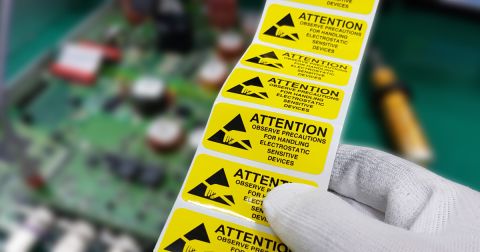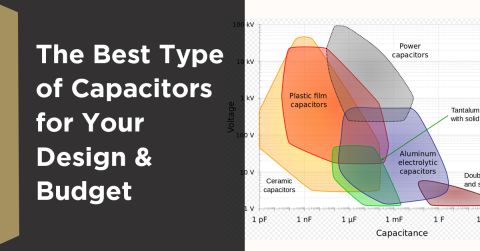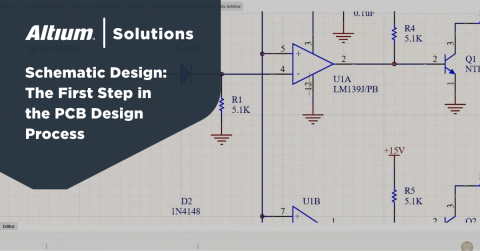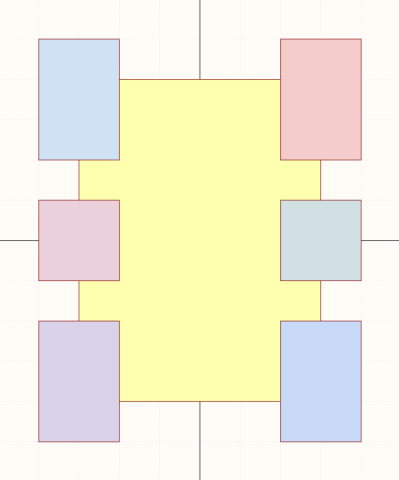How Do Ferrite Beads Work and How Do You Choose the Right One?

Ferrite beads (sometimes used interchangeably called a ferrite choke, ferrite clamp, ferrite collar, EMI filter bead, or even a ferrite ring filter) can be a bit of a mystery. The electrical function of a ferrite bead resembles that of an inductor, but a ferrite bead's frequency response deviates from this functionality at high frequencies. Additionally, different types of ferrite beads and ferrite materials, such as wirewound ferrite beads and chip ferrite beads, provide different responses to noise reduction. For example, wirewound ferrite beads operate over a wide range of frequencies but offer less resistance in direct current setups.
In order to use them properly, you’ll need to understand their electromagnetic characteristics and how they change during use. After you’ve got a handle on the theory behind ferrite bead uses, you can deliberately select one for your PCB in instances where they are needed. Incorrect selection of these components can create more problems than they fix due to creation of radiated EMI or limiting of channel bandwidth (or both), which will prevent power or signal from reaching a load.
What is a Ferrite Bead and How Do Ferrite Beads Work?
Ferrite beads are passive electronic components that can suppress high frequency signals on a power supply line or a signal line. They provide this suppression by acting like resistors within a narrow frequency range. By placing a ferrite bead in series with a power/signal line and its load, the bead provides filtering by absorbing power near the ferrite bead's resonant frequency. These components are often found in standard passive component packaging (0402, 0603, etc.).
Ferrites beads are made from magnetic materials, which may tempt you to think of them as a standard inductor. Ferrite bead behavior can be approximated with the simplified circuit model shown below. In this model, the electrical behavior of the ferrite bead is modeled as a parallel RLC network with a small current-limiting series resistor. The series resistor quantifies the device’s current limit at DC.
A simple yet accurate circuit model of a ferrite bead connected to an AC power source.
The inductor in this model represents a ferrite bead's primary function of attenuating high-frequency signals, i.e., providing inductive impedance through Faraday’s Law. The parallel resistor in this model accounts for losses in eddy currents that are induced within the ferrite bead at high frequencies. Finally, the capacitor in this model accounts for the component’s natural parasitic capacitance.
Because ferrite beads are magnetic components, they can experience magnetic saturation at high current, thus their electrical behavior can change as a function of current and temperature. A ferrite bead is a nonlinear component at high current; the impedance it provides changes as the load current and voltage drop across the ferrite change. As DC current increases, a ferrite bead will "saturate" and lose inductance. At relatively high currents, saturation can reduce the ferrite bead impedance by up to 90%.
Ferrite Bead Circuit Models and Their Impedance: How Accurate Are They?
We get a full picture of ferrite bead impedance by looking at the impedance curve of a ferrite bead. For example, take a look at part number MPZ1608B471A from TDK; the graph below shows the impedance curve for this ferrite bead component, illustrating a resonant frequency of 200 MHz and peak impedance of ~470 Ohms. The difference between these curves and a parallel RLC circuit is the broad impedance bandwidth and the very broad frequency range where the component exhibits resistive impedance.
Ferrite bead impedance curve for part number MPZ1608B471A from TDK
Unfortunately, graphs in a datasheet are not so useful for simulating ferrite bead behavior, and not all vendors provide SPICE models which capture the above impedance characteristics. However, the circuit model parameters can be determined by looking at a few characteristics of the impedance graph.
For example, take a look at the impedance curve for part number MH2029-401Y. Using the impedance graph for this ferrite bead, we can arrive at the following circuit model parameters:
- Resonant frequency: 160 MHz
- C = 0.842 pF
- L = 1.18 uH
- R = 450 Ohms
- FWHM = 420 MHz (initial guess based on the FWHM value from the impedance curve)
The resulting impedance curve (and resistance/reactance curves) are shown alongside the measured data using the same scale in the impedance graph below. The accuracy is acceptable from DC up to the peak in the impedance curve.
Although the circuit model captures the overall shape of the curve, the model circuit model appears to overestimate the total impedance and resistance above the resonant frequency. This type of comparison is quite important for understanding the validity of a ferrite bead circuit model in a SPICE simulation, and it illustrates the results are not trustworthy above resonance unless some changes are made to the model. However, the typical frequency range being considered in ferrite bead usage is from DC to the resonant peak, as I have explained below, so for most applications this model will be sufficient as long as the applicability range is understood.
The mathematical process for determining appropriate circuit parameters has the same difficulty as a typical homework problem involving RLC circuits. Simple formulas or trial-and-error can be used to determine decent estimates of the circuit element values in the above circuit model for commercially available ferrite beads. Learn more about the mathematical process for determining ferrite bead circuit model values in this linked article, or watch the video below.
Where Ferrite Beads Are Typically Used
Because ferrite bead impedance is inductive at low frequencies and low impedance at DC, ferrite beads can pass low frequencies and attenuate higher frequencies until you reach the ferrite bead's resonance. For this reason, a ferrite bead is sometimes placed on a PCB connected to the power input coming into an electronic device as this can remove spurious high frequency noise present on the power connection. For higher current devices, a ferrite choke (a.k.a., ferrite core or ferrite ring) would be used directly on the power cord as it performs the same function.
Most commonly in power systems with 3-wire AC inputs, ferrite beads will not be used on the input power line. Instead, common-mode chokes and differential-mode filter circuits will be used directly on the power input circuitry (before any rectification or transformer), where the earth connection is used to pass differential AC noise to earth ground. The same applies on DC power lines coming into a system from a connector; the choke is used to suppress common-mode noise but with higher current ratings than would be found in a typical ferrite bead. However, at lower currents, ferrite beads could be attached directly to connector pins to suppress noise, but this should be tested against 0 Ohm resistors for power system response and radiated EMI.
When Ferrite Beads Should Not Be Used
A ferrite bead should never be used in cases where the impedance spectrum of the ferrite overlaps with the power spectrum or channel bandwidth you need to provide to a load. This is best illustrated in two examples:
- Example 1: Power supplies for digital components need to supply power up to the GHz range with fast edge rates. A ferrite can strongly filter in this range, therefore it should not be used in these cases. However, if the power supply only needs to provide DC power, then the ferrite bead is probably acceptable because it will not filter DC power.
- Example 2: High-speed digital interfaces require a minimum amount of channel bandwidth in order to transfer a signal between two components. A ferrite component should not be used when the impedance peak lies in the required channel bandwidth range.
We can come up with several other instances where ferrite beads should never be used:
- As a high frequency noise filter in a digital PDN
- To isolate two different power rails at the same voltage
- In the output feedback loop of a power supply for fast digital components
- As a filtering element on a MOSFET gate with PWM driving
- As a filtering element on supply lines for motors
Why do so many designers continue to use ferrite beads in these instances, despite the wealth of evidence showing they create problems with circuit functionality? There are several reasons for this, some of which are discussed by Kella Knack in this linked article. I think the most significant reason is that evaluation boards for power products and older reference designs continue to include ferrite beads, and designers will see this usage and assume it is required to include these in every other design. I have even seen some of our 1-minute design reviews where the same ferrite bead is placed on many different power lines and interfaces, which clearly shows that little thought was placed into whether the beads were needed or what their function would be.
To learn more about improper uses of ferrites, especially as they relate to the use of a ferrite beads on digital components, watch the video below. You can also read this linked blog to learn more.
Ferrite Bead vs. Inductor
Although a ferrite bead can be modeled as an inductor at low frequencies, ferrite bead inductors do not behave as a typical inductor. If you’re wondering how to measure the behavior of a ferrite bead vs. inductor behavior, you will want to measure the bead impedance over frequency or create a Bode plot for the ferrite bead. When compared to an inductor with the same reactance slope at low frequencies, you’ll find that the ferrite bead provides steeper roll-off above the ferrite's resonant frequency.
To briefly summarize, ferrite beads are not substitutes for inductors. If your circuit needs an inductor, then use an inductor, and always test a particular ferrite bead for a circuit in order to prove it will work for your application.
Ferrite Bead Selection Guide
The rules for selecting a ferrite bead for a particular circuit are deceptively simple and often ignored in practice. I've narrowed down to three simple rules:
- Don't use a ferrite bead at all unless you've identified a specific problem that needs a ferrite bead.
- Select a bead with stopband that does not overlap with the frequency range you need to transfer to your load.
- Make sure that the saturation current is greater than your operating current.
The most common rule that is broken in this process is Rule #1. Next, assuming you determine you need a ferrite bead, many designers will break Rule #2. We can see how to implement it correctly with an example. Rule #3 is the simplest to follow, but this is often the starting point for designers rather than the ending point.
The graph below shows the impedance curve for part number MH1608-221Y from Bourns. An example power spectrum or channel bandwidth that a circuit might require for operation is shown overlaid in the red curve (dB scale). Because the ferrite bead impedance curve does not overlap significantly with the power spectrum curve, the bead could be appropriate for the application being considered.
Additional Resources For Understanding Ferrite Beads
To help designers use ferrite beads correctly and effectively, we have created a large number of resources and compiled them here. Take a look at the articles listed below for more information on ferrite bead usage, electrical characteristics, and their effects in specific applications.
- Ferrite beads and EMI:
- Ferrite bead circuit characteristics:
- Simulation applications:
- Other resources:
In Summary
Ferrite beads can be useful, but only if you understand exactly how they will work in your particular circuit. Remember that they attenuate signals in a narrow frequency by applying resistance, and their effectiveness depends on temperature and load current. In order to best use a ferrite bead, you should evaluate the usage of the bead in testing and measurements. Simulations with ferrite beads are also possible with the above circuit model or using a model provided by a manufacturer. Ferrite beads can be acquired from manufacturers such as Coilcraft, Murata, or Würth Elektronik, and these manufacturers do an excellent job of providing comprehensive documentation and models for their products.
Whether you need to build reliable power electronics or advanced digital systems, use Altium’s complete set of PCB design features and world-class CAD tools. Altium Develop provides the world’s premier electronic product development platform, complete with the industry’s best PCB design tools and cross-disciplinary collaboration features for advanced design teams. Experience Altium Develop today!











